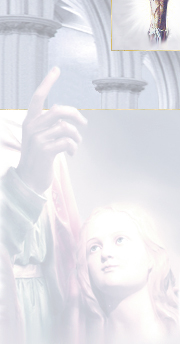|
|
|
Learning How to Pray |
Spiritual Counsels |
Books |
About CSF
The
Apostles’ Creed | The Nicene
Creed
The Apostles’
Creed
“The
Apostles’ Creed is so called because it is rightly considered to
be a faithful summary of the Apostles’ faith. It is the ancient baptismal
symbol of the Church of Rome. Its great authority arises from this fact:
it is the Creed of the Roman Church, the See of Peter the first of the Apostles,
to which he brought the common faith” (Catechism of the Catholic
Church, 194).
The Apostles’ Creed is used as a component of other formal prayers, such as
the Rosary and the
Chaplet of the Divine Mercy.
|
 |
|
I
BELIEVE in God
the Father almighty
creator of Heaven and Earth;
and in (bow head) Jesus Christ,
His only Son,
our Lord,
Who was conceived
by the Holy Spirit,
born of the Virgin (bow head) Mary,
suffered under Pontius Pilate,
was crucified, died,
and was buried.
He descended into hell;
on the third day
He rose again from the dead.
He ascended into Heaven,
and is seated at the right hand
of God, the Father Almighty.
From thence He will come
to judge the living and the dead.
I believe in the Holy Spirit,
the holy Catholic Church,
the communion of Saints,
the forgiveness of sins,
the resurrection of the body,
and life everlasting.
Amen. |
 |
CREDO
in Deum,
Patrem omnipoténtem,
Creatórem cœli et terræ.
Et in (fit reverentia) Iesum Christum,
Fílium ejus únicum,
Dóminum nostrum;
qui concéptus est
de Spíritu Sancto;
natus ex (fit reverentia) María Vírgine;
passus sub Póntio Piláto,
crucifíxus, mórtuus,
et sepúltus:
Descéndit ad inféros;
tértia die
resurréxit a mórtuis:
ascéndit ad cœlos,
sedet ad déxteram
Dei Patris omnipoténtis;
inde ventúrus est
judicáre vivos et mórtuos.
Credo in Spíritum Sanctum,
sanctam Ecclésiam cathólicam,
Sanctórum communiónem,
remissiónem peccatórum,
carnis resurrectiónem,
vitam ætérnam.
Amen. |
The Nicene
Creed
“The
Niceno-Constantinopolitan or Nicene Creed draws its great authority
from the fact that it stems from the first two ecumenical Councils (in 325
and 381). It remains common to all the great Churches of both East and West
to this day.” (Catechism of the Catholic Church, 195).
The Nicene Creed, also called the Profession of Faith, is used at
Mass on all Sundays, Solemnities, and local celebrations
of a solemn character. (See
GIRM, 68.)
|
 |
|
I
BELIEVE in one God, the Father Almighty, maker of heaven and earth,
of all things visible and invisible. |
 |
CREDO
in unum Deum, Patrem omnipoténtem, factórem cæli et
terræ, visibílium ómnium et
invisibílium. |
|
 |
|
I believe in one Lord
(bow head) Jesus Christ,
the Only Begotten Son of God, born of the Father before all ages. God from God,
Light from Light, true God from true God, begotten, not made, consubstantial with
the Father. Through Him all things were made. |
 |
Et in unum Dóminum
(fit reverentia) Iesum Christum,
Fílium Dei unigénitum, et ex Patre natum ante
ómnia saécula. Deum de Deo, lumen de lúmine, Deum verum
de Deo vero. Génitum, non factum, consubstantiálem Patri; per
quem ómnia facta sunt. |
|
 |
|
For us men and for our
salvation He came down from heaven,
Bow (or genuflect)
and by the Holy Spirit was incarnate
of the Virgin Mary, and became man. |
 |
Qui propter nos hómines, et propter nostram salútem, descéndit de
cælis.
Fit reverentia
Et incarnátus est de Spíritu Sancto ex María
Vírgine: et homo factus est. |
|
 |
|
For our sake He was
crucified under Pontius Pilate, He suffered death and was buried, and rose
again on the third day in accordance with the Scriptures. He ascended into
heaven and is seated at the right hand of the Father. |
 |
Crucifíxus
étiam pro nobis sub Póntio Piláto, passus et sepúltus
est, et resurréxit tértia die, secúndum Scriptúras,
et ascéndit in cælum, sedet ad déxteram
Patris. |
|
 |
|
He will come again in
glory to judge the living and the dead, and His kingdom will have no
end. |
 |
Et iterum ventúrus
est cum glória iudicáre vivos et mórtuos: cuius regni
non erit finis. |
|
 |
|
I believe in the Holy
Spirit, the Lord, the giver of life, Who proceeds from the Father and the
Son, Who with the Father and the Son is
(bow head) adored
and glorified, Who has spoken through the prophets. |
 |
Et in Spíritum
Sanctum Dóminum et vivificántem, qui ex Patre Filióque
procédit. Qui cum Patre et Fílio
(fit reverentia) simul adorátur
et conglorificátur: qui locútus est per
Prophétas. |
|
 |
|
I believe in one holy
catholic and apostolic Church. |
 |
Et unam, sanctam,
cathólicam et apostólicam Ecclésiam. |
|
 |
|
I confess one baptism
for the forgiveness of sins, and I look forward to the resurrection of the
dead  and the life of
the world to come. Amen. and the life of
the world to come. Amen. |
 |
Confíteor unum
baptísma in remissiónem peccatórum. Et expécto
resurrectiónem mortuórum,  et vitam ventúri saéculi.
Amen.
et vitam ventúri saéculi.
Amen. |
|



